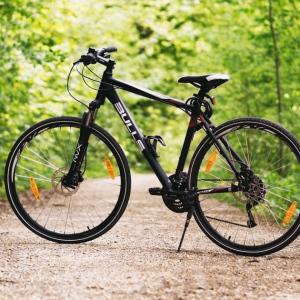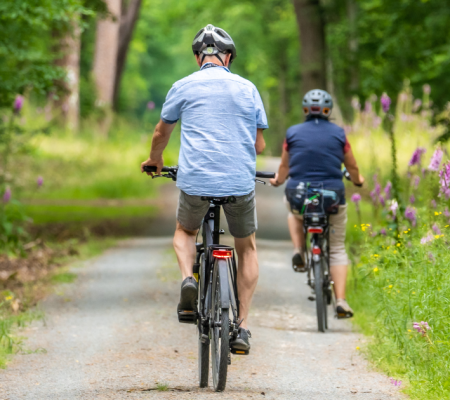Stay Safe and Enjoy the Ride: Essential Summer Biking Tips and Benefits
As summer approaches, there is no better time to get outside and explore. Hopping on a bicycle is the perfect way to combine summer wanderlust with a low-impact physical activity that provides many benefits. Not only do you gain mental health benefits from exercising and sunshine, but biking can also be excellent exercise to improve your joint health and fitness.
At Orthopaedic Hospital of Wisconsin, we want to help you live an injury and pain-free lifestyle. If you’re eager to hop on your bike this season, read more to learn about the benefits of biking and our bicycling safety tips to help you have a safe and smooth ride.
Before You Ride: Bicycle Safety Tips
-
Choose the Right Bike for You
 Before you hit the road or trail, selecting a suitable bike is an essential first step for bicycle safety. If you’ve ever attempted to ride a bike that didn’t fit you correctly, you know it feels uncomfortable and is potentially dangerous.
Before you hit the road or trail, selecting a suitable bike is an essential first step for bicycle safety. If you’ve ever attempted to ride a bike that didn’t fit you correctly, you know it feels uncomfortable and is potentially dangerous.
When selecting the right bike, your feet should touch the ground while you are seated. You should feel balanced, and your seat should be comfortable. You should be able to pedal smoothly, without your knees not fully extending.
For help finding a bike that is the right size, you can use a bike size chart. Additionally, bike shops and sporting goods retailers have staff to help you find the right fit. It’s also important to select the type of bike that will match the activities you are comfortable with. You may prefer a mountain bike, road bike, or hybrid. For short, leisurely trips around town, you may prefer a casual “beach cruiser.” Whatever type of bike you choose, the key is to find a bike you enjoy and feel comfortable riding.
-
Bring the Right Gear
-
Helmet
- A helmet is an essential aspect of bicycle safety. Even if you go for a short ride a helmet can protect you from serious injury. Purchase a comfortable helmet that is of quality.
-
Reflective Gear, Lights, & Bells
- Bringing along the proper gear can help assist you with a safe ride. For instance, while a bike bell may seem needless, it can be a useful safety tool. It can help warn people when you are approaching – improving everyone’s safety on a crowded trail or pedestrian walkway. Reflective lights are also critical for safe biking. You can purchase specially designed bike clothing with reflective patterns or LED lights or just use a few strips of reflective tape to improve your visibility on the road.
-
Phone, a Small First Aid Kit & Water
- Being prepared for any conditions while you ride a bike is ideal for a safe ride. A small zip pack can carry your phone and essentials. A biking first aid kit should contain bandages for blisters, sunscreen, lip balm, and alcohol prep pads. If your biking journey is long, you may also want to bring a patch kit and bike repair tools. Bringing along a bottle of water is also necessary. Hydration is crucial to your health and safety. Also, keep your phone with you on a bike trip. It can help you plan your route and call for help if necessary.
-
Listen to Your Body
If you are new to riding bikes, it’s wise to begin with short rides and work up to longer ones. Taking breaks is also important to ensure your body is rested and not overworked.
While biking, stay attentive to how your body is feeling. As you build up to a longer ride, stay aware of any discomfort. Upper back pain can indicate that you should reposition your handlebars or seat. Knee, hip, or ankle pain could indicate a strain or injury. Don’t cycle through the pain. If you’re experiencing discomfort during your bike rides, check in with a professional.
Benefits of Biking

-
Cardiovascular Health
Cycling is an excellent option for cardiovascular exercise. While biking, your heart is stimulated, which will strengthen your heart muscles, help your lungs, and improve your circulation. This will lower your risk of cardiovascular diseases such as heart attack, stroke, and high blood pressure.
-
Low Impact Exercise
Biking limits the stress on your weight-bearing joints, making it a low-impact exercise. This can be helpful if you experience hip or knee pain. Cycling can also help strengthen the muscles that support your knees, leading to a lesser chance of pain or injury. Biking will also help you build muscles in your quads, glutes, and calves. Maintaining a higher heart rate while biking will also help you burn calories, leading to weight loss.
-
Reduces Risk of Arthritis
Biking keeps your joints in constant motion. This helps to lubricate the joints and reduces friction, which can help protect the joint and provide nutrients to the cartilage. This can help explain why cyclists were 21% less likely to have X-ray evidence and symptoms of osteoarthritis compared to those who did not have a history of bicycling, according to a recent study.
-
Improves Mental Health
While you cycle, your body will naturally release endorphins, the hormone that reduces stress levels. This process also helps to release serotonin, the hormone that helps control sleep and your overall well-being. The mix of endorphins and serotonin release will help clear your mind and reduce anxiety, leading to improved mental health.
At Orthopaedic Hospital of Wisconsin, we want you to enjoy cycling or any other activity. If pain, discomfort, or injury is keeping you from participating in a physical activity like biking, our team of orthopedic specialists is here to help. Make an appointment today so that you can return to a pain-free lifestyle.


